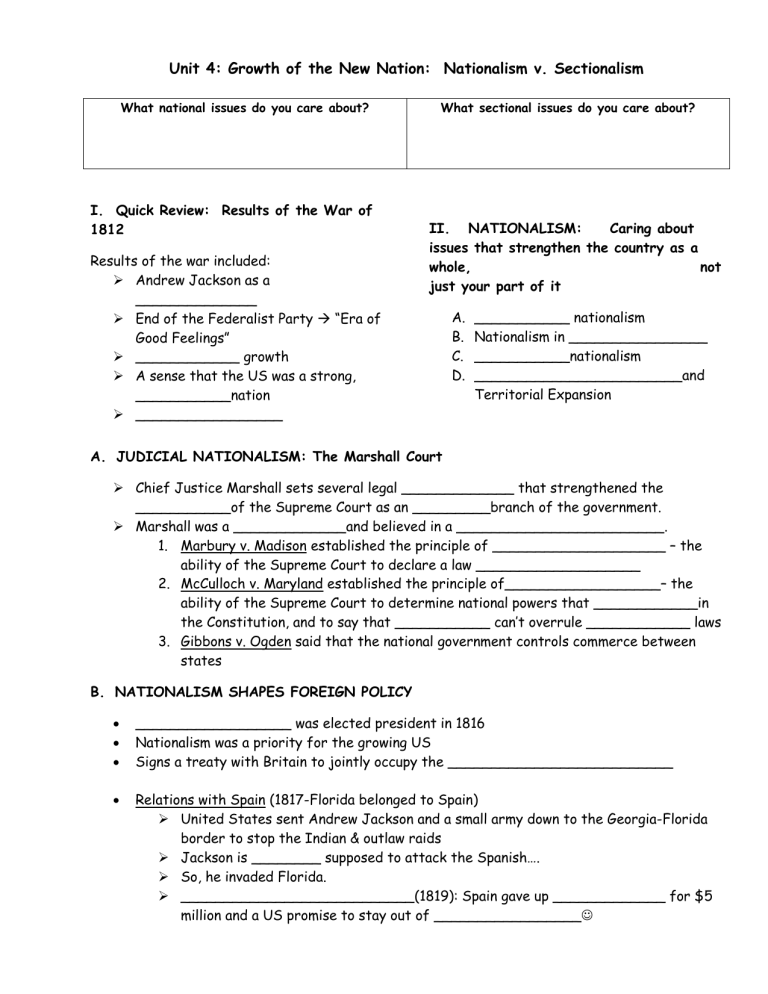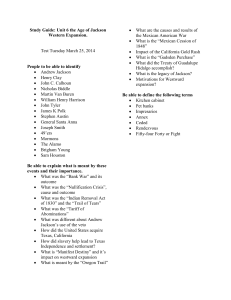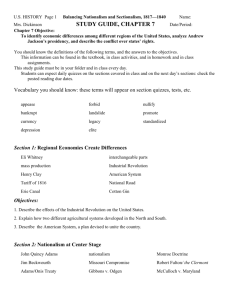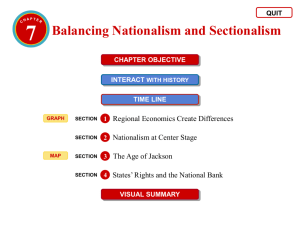Do you think Jackson deserves to be on the $20 bill?

Unit 4: Growth of the New Nation: Nationalism v. Sectionalism
What national issues do you care about? What sectional issues do you care about?
I. Quick Review: Results of the War of
1812
Results of the war included:
Andrew Jackson as a
______________
End of the Federalist Party “Era of
Good Feelings”
____________ growth
A sense that the US was a strong,
___________nation
_________________
II. NATIONALISM: Caring about issues that strengthen the country as a whole, just your part of it not
A.
JUDICIAL NATIONALISM: The Marshall Court
A.
___________ nationalism
B.
Nationalism in ________________
C.
___________nationalism
D.
________________________and
Territorial Expansion
Chief Justice Marshall sets several legal _____________ that strengthened the
___________of the Supreme Court as an _________branch of the government.
Marshall was a _____________and believed in a ________________________.
1.
Marbury v. Madison established the principle of ____________________ – the ability of the Supreme Court to declare a law ___________________
2.
McCulloch v. Maryland established the principle of__________________– the ability of the Supreme Court to determine national powers that ____________in the Constitution, and to say that ___________ can’t overrule ____________ laws
3.
Gibbons v. Ogden said that the national government controls commerce between states
B.
NATIONALISM SHAPES FOREIGN POLICY
__________________ was elected president in 1816
Nationalism was a priority for the growing US
Signs a treaty with Britain to jointly occupy the __________________________
Relations with Spain (1817-Florida belonged to Spain)
United States sent Andrew Jackson and a small army down to the Georgia-Florida border to stop the Indian & outlaw raids
Jackson is ________ supposed to attack the Spanish….
So, he invaded Florida.
___________________________(1819): Spain gave up _____________ for $5 million and a US promise to stay out of _________________
The Monroe Doctrine
Other ______________ powers were planning to (re)take their colonies in the
Caribbean and Latin America. In his 1823 address to Congress, Monroe made it clear to Europe:
_________________ with the Western Hemisphere:
The ______________________________________
What is the main idea of the cartoon? Write a caption for it.
Draw an image to help you remember the Monroe Doctrine.
The American continents
__________________ be considered for future
__________________by any European powers
Nations in the Western
Hemisphere were just
_____________ from nations in Europe,
___________________
________________
The US would see any attempt by Europe to take any country in the Western
Hemisphere as a
___________________
_____________________
____________
The United States would not
______________ in European
How do you think Europe responded to the Monroe Doctrine? affairs.
What do you think the short-terms effects of the Monroe Doctrine might be? Long-term effects?
Unit Four, Continued: Growth of the New Nation: Nationalism v. Sectionalism
We have already discussed:
A.
Judicial Nationalism (The Marshall Court)
B.
Nationalism in Foreign Policy (Florida/Adams-Onis Treaty and the Monroe Doctrine)
C.
Economic Nationalism (American System, Cotton & Industrialization)
Next stops:
Westward Expansion and our favorite hero/villain…Andrew Jackson
By the end of the unit, we will see that sectionalism becomes more important than nationalism.
C. ECONOMIC NATIONALISM (A quick review)
Regions Create Differences
The __________________ continued to develop _________________ while the South and West continued to be more _____________________
The Industrial Revolution reached America by the early-mid 19th century
________________________ first to embrace ______________system, especially in
______________ (fabric) mills
Meanwhile, the South continued to grow as an agricultural power
___________________ invention of the ______________________ (1793) made producing cotton even more profitable
The South became a _________________________
More labor was needed – 1790 = 700,000 slaves …………..1820 = 1,500,000 slaves
Balancing Nationalism and Sectionalism
Economic differences created political tension between North & South
The industrial North ___________________ high protective tariffs to protect
Northern manufactured goods from foreign competition.
The agricultural South __________________high tariffs that made the price of imports more expensive.
NORTH on tariffs SOUTH on tariffs
As the regions moved apart, politicians attempted to keep nation together
House Speaker Henry Clay’s _____________________________ called for a protective tariff, a National Bank, and an improved infrastructure to help travel:
The ____________________ (and roads, and railroads)
D. WESTWARD EXPANSION, JACKSONIAN DEMOCRACY AND MANIFEST DESTINY
1820: The Missouri Compromise: A national solution to a sectional problem
Complete the separate handout on the Missouri Compromise. Why was the Missouri Compromise only a temporary solution?
Jacksonian Democracy
During a time of growing Sectionalism, ______________________________ election in
1828 ushered in a new era of ________________ democracy
Things I learned about Andrew Jackson on this slide: o Did not trust (or like) the ________ and ___________________. o What else?
Jackson tries and fails to be president, in The Election of 1824: “the Corrupt Bargain”
Jackson _______________ the popular vote
Jackson had more ______________________ than anyone else, but not enough for a majority
The House of Representatives chooses __________________________ as Pres.
Jackson is furious that his election was “stolen”: the “__________________________"
The Election of Andrew Jackson in 1828 (Finally)
Jackson, hero of the __________________, won election in 1828 in part because the
____________________________________________________ to more citizens
1824: ___________________ white males voted (wealthy property owners)
1828: ___________________ white males voted – many new voters supported Jackson
Why do you think these new voters supported Jackson?
As part of his political philosophy, Jackson sought to grant political power to the common people: __________________________________
Jackson ___________________ his own _____________________with government jobs. This is called ____________________________.
Jackson gave away many jobs to his friends and political allies and fired the rich and powerful __________.
[SOL ALERT] “The age of the common man” was characterized by
heightened emphasis on equality in the political process for adult white males
the rise of interest group politics and sectional issues
a changing style of campaigning – political parties tried to appeal to “folks”
increased voter participation.
Politics started to look like what we know today. Do you think these changes were good or bad for the nation?
CONTROVERSY AND CONFLICT: Is Jackson a hero or a villain?
Jackson’s Native American Policy
________________________________ of 1830 – Forced resettlement of Native
Americans (______________, Creek, Chickasaw, Choctaw, Seminole) from their homes in the SE to Oklahoma and lands west of the Mississippi River.
Bureau of Indian Affairs created to oversee resettlement – many forced onto
_____________________________
Worcester -v- Georgia – Cherokee claimed the relocation was wrong and it went to the supreme court. _________________ ruled in _____________of the Cherokee Tribe.
Jackson’s response:
“Marshall has made his decision, now let him _______________it”
A slap in the face to the Supreme Court.
This forced migration was called the ____________________________. Over ¼ of the
Cherokees died on the journey.
The Tariff of Abomination and the Nullification Crisis (more tariffs!)
In 1824 and again in 1828, Congress increased the _____________________ of 1816
Southerners called the 1828 Tariff, “a Tariff of _____________________” and blamed it for economic problems in the ______________
In an attempt to free South Carolina from the tariff, John Calhoun (Jackson’s
___________________ from S.C.), developed the Theory of ____________________
South Carolinians argued that states could ________________ the Tariff of 1832 and other acts of Congress if they found them to be unconstitutional. Nullification would
________________________________within the state.
Jackson threatened to send federal troops to SC
Why was the threat of Nullification a “crisis” for the nation?
Jackson’s Bank War (remember that National Bank? AJ hates it!)
Jackson opposed the __________________ – run by the rich and powerful.
He ___________ its charter and withdrew all the federal $$. He created
__________________ run by Dems and his friends
Many felt Jackson was acting more like a _____________than a president
His opponents formed a new party – the ___________________.
After Jackson left office, the economy CRASHED because the Pet Banks printed too much money.
In ____________________________and many banks closed, accounts went bankrupted, and unemployment soared – an economic depression.
Jackson’s Legacy: Hero or Villain?
The Good
More democratic involvement in Government
Looked out for the interests of the Common Man
Strong Executive Power
Massive Voter Turnout
Sparked Re-Creation of 2 Party System
The Bad
The Spoils System
Banking Instability
Excessive Check of the Supreme Court
Greater Sectionalism –Result of his Split with Calhoun
The Ugly
Native American Policy
Trail of Tears
Do you think Jackson deserves to be on the $20 bill?
Unit Four, STILL Continued! We’re almost done!
Growth of the New Nation: Nationalism v. Sectionalism
We have already discussed:
A.
Judicial Nationalism (The Marshall Court)
B.
Nationalism in Foreign Policy (Florida/Adams-Onis Treaty and the Monroe Doctrine)
C.
Economic Nationalism (American System, Cotton & Industrialization)
D.
Our favorite hero/villain…President Andrew Jackson
E.
Now, finally….Westward Expansion and Manifest Destiny
List all the scenes you can see in the picture. Who or what can you see, and what do they seem to be doing? What do you think the people might be thinking?
1.
Reasons for Expansion a.
Manifest Destiny – the United States has the God-given right to expand from one end of the continent (the ________________) to the other (the ______________) b.
Eli Whitney’s ________________________ i.
Led to the spread of slavery by making cotton farming more profitable ii.
Helped create a “_____________________” in the South c.
________________________________ i.
Made movement of goods and people easier and helped grow the
______________________________
2.
Texas a.
Texas was a province in Mexico. ___________ won their
_________________________from Spain in 1821 and Texas was theirs. i.
In the 1820s – Mexican officials offered land to Americans to make the area more stable. Americans began to move to Texas to get land to grow cotton. ii.
Americans soon outnumbered Mexicans in Texas – trouble started. iii.
Stephen ________________ established an American colony in Mexico. iv.
Conflicts grew between Mexicans and Americans in Texas. v.
One issue was the _____________that many Americans had brought with them. vi.
Mexico had ___________________________________in 1829. b.
Remember the Alamo! i.
Mexican President ________________ was determined to force Texans to obey
Mexican law. ii.
In ___________, there was an armed revolt of American Texans against Mexican rule. iii.
American forces moved into a mission known as the _________________. iv.
After 13 days the Mexican troops scaled the walls and __________________
________________________________________. c.
Mexican-American War i.
In 1844 President James Polk, eagerly wanted to annex Texas as part of the U.S. ii.
Negotiations failed and U.S. troops moved into Mexican territory iii.
America victories soon followed, and in 1848 Mexican leader Santa Anna admitted defeat iv.
Treaty of Guadalupe Hidalgo was signed – U.S. gets present-day _______,
___________________________________________________________
3.
California Gold Rush a.
____________________ is discovered at Sutter’s Mill in California in _______________ b.
Folks who rushed to San Francisco in 1849 became known as _________________ c.
By 1857, the total amount of gold mined in California topped $2,000,000,000!







